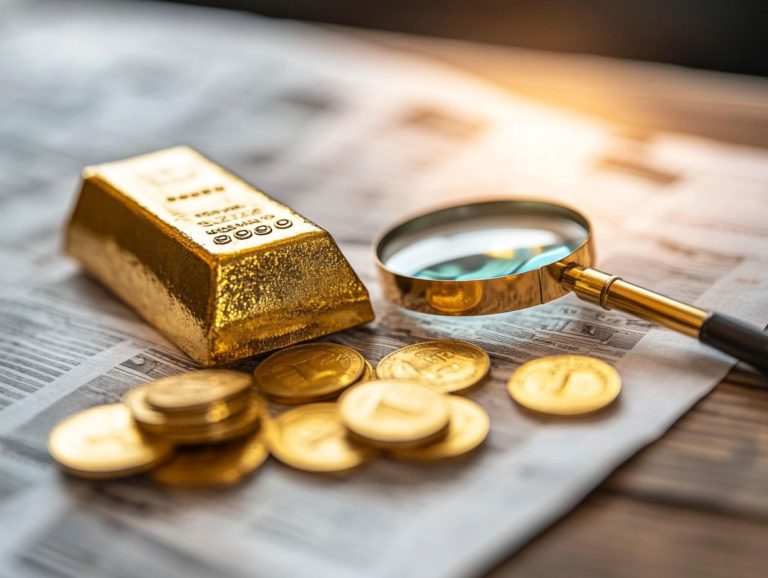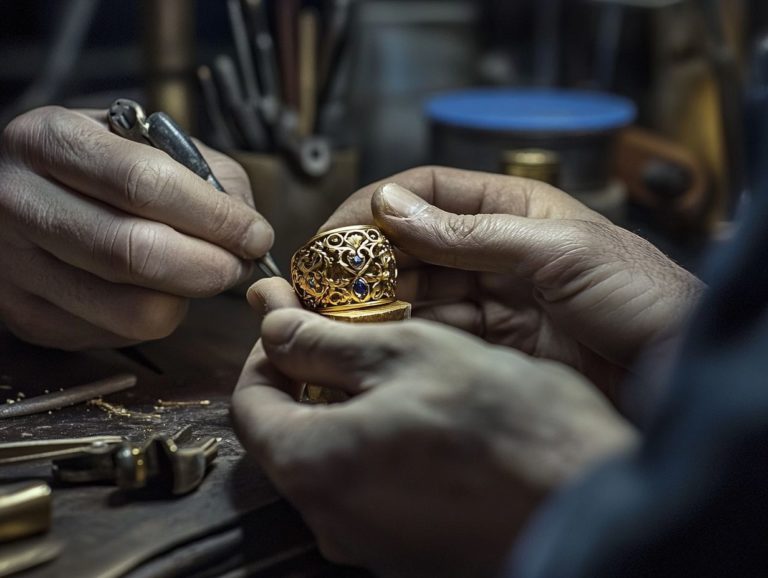5 Must-Know Terms in Precious Metal Investing
Investing in precious metals may feel overwhelming at first, but understanding a few key terms can significantly simplify the journey.
From the nuances of spot prices to the captivating world of bullion and numismatic coins, this article lays out the essential concepts every investor should be familiar with.
You’ll delve into the factors that influence metal prices and weigh the benefits and risks of investing. Additionally, you will discover practical tips to kick-start your adventure.
By the end, you’ll have a much clearer understanding of how to navigate the realm of precious metal investing with confidence and ease.
Contents
- Key Takeaways:
- 1. Spot Price
- 2. Bullion
- 3. Numismatic Coins
- 4. Premium
- 5. Spread
- What Is Precious Metal Investing and Why Is It Popular?
- What Are the Different Types of Precious Metals?
- What Are the Factors That Affect Precious Metal Prices?
- What Are the Benefits of Investing in Precious Metals?
- What Are the Risks of Precious Metal Investing?
- How Can One Get Started with Precious Metal Investing?
- What Are the Common Mistakes to Avoid in Precious Metal Investing?
- How Can One Diversify Their Precious Metal Investment Portfolio?
- What Are the Tax Implications of Precious Metal Investing?
- What Are the Different Ways to Buy and Sell Precious Metals?
- What Are the Future Projections for Precious Metal Prices?
- Frequently Asked Questions
- What are the 5 must-know terms in precious metal investing?
- What is spot price and why is it important?
- What is bullion and how does it differ from numismatic coins?
- What is the spot market and how does it affect precious metal prices?
- What is the difference between intrinsic value and market value in precious metal investing?
- Why is it important to understand these terms before investing in precious metals?
Key Takeaways:

Spot Price is the current market value of a precious metal, which fluctuates based on supply and demand.
Bullion refers to coins or bars made of precious metal which are valued based on their weight and purity.
Numismatic Coins are collectible coins with historical or aesthetic value, which can have a higher premium than bullion coins.
1. Spot Price
The spot price of precious metals, including gold and silver, is in a constant state of flux. It is influenced by the changing levels of supply and demand, market volatility, and geopolitical events.
This price is essential for you as an investor considering a foray into gold investment or exploring the silver market. It reflects the current value that buyers are willing to pay for immediate delivery, capturing real-time economic conditions.
Several factors contribute to these price swings, including currency strength, inflation data, and shifts in interest rates. Investor sentiment can greatly affect the market; during uncertain times, the allure of bullion coins tends to rise, driving demand and impacting spot prices.
For those engaged in commodities investment, grasping these nuanced interactions is crucial. It can empower you to make informed decisions, providing strategic advantages in navigating a landscape that can be as volatile as it is rewarding.
2. Bullion
Bullion, which encompasses physical gold and silver in the form of bars or coins, represents an enticing option for you as an investor. It allows you to navigate the precious metal market while ensuring both liquidity and stability in your investment portfolio.
Among the myriad of choices, the American Gold Eagle and coins minted by the Royal Canadian Mint truly shine due to their exceptional purity and craftsmanship. These forms of bullion, favored by collectors and investors alike, not only offer a secure store of value but also act as a robust hedge against inflation and economic uncertainty.
By incorporating bullion into your investment strategy, you can enhance diversification and effectively reduce overall portfolio risk. The intrinsic value of these precious metals often appreciates over time, making them a compelling addition to a well-rounded financial approach.
3. Numismatic Coins
Numismatic coins, with their collectible charm and rich historical significance, offer you a distinctive path for gold investment. Unlike standard bullion, these coins have the potential to deliver higher returns and appreciation, driven by their rarity and demand.
Each coin tells a story from a different era, adorned with intricate designs that reflect its cultural heritage. You’ll discover that certain coins can skyrocket in value due to their connection to historical events or notable figures, adding an extra layer of allure to your investment.
However, diving into the world of numismatics isn’t without its challenges. Fluctuations in demand can affect prices, and distinguishing genuine coins from replicas requires a keen eye and expertise.
Evaluating these coins as part of your diversified asset portfolio can be rewarding. However, it’s crucial to conduct thorough research and consider seeking professional appraisals to navigate potential pitfalls effectively.
4. Premium
The premium on precious metals like gold is crucial. It signifies the cost above the spot price, which is the current market price for immediate delivery. This premium is influenced by the metal’s purity, current demand, and the range of investment options available.
Market conditions can cause these premiums to fluctuate over time. For instance, during economic uncertainty, demand often surges as investors seek safe-haven assets, driving premiums higher.
Supply chain issues also impact prices significantly. Disruptions can lead to scarcity, pushing prices higher. The popularity of specific products, such as bullion coins or bars, can result in pricing discrepancies.
It’s vital to conduct a comprehensive analysis of these factors if you’re looking to make informed investment decisions in the precious metals market.
5. Spread
The spread in the precious metal market refers to the gap between what you pay to buy and what you get when you sell gold and silver. This gap can greatly affect your returns, especially during market volatility.
This pricing difference can lead to higher costs for traders, ultimately eroding overall profitability.
It s wise to consider strategies like working with brokers who offer lower spreads or using limit orders to minimize these costs.
Understanding how spreads relate to your asset allocation is essential. By diversifying your portfolio across various asset classes, you can effectively mitigate the risks tied to high spreads in any single investment.
A balanced approach not only shields you from fluctuations but also optimizes your overall performance, even when spreads widen.
What Is Precious Metal Investing and Why Is It Popular?

Precious metal investing, particularly in gold and silver, has gained immense popularity among investors seeking a hedge against inflation and a safe haven during economic downturns. This interest stems from the historical performance and intrinsic value these metals have during market fluctuations.
As you navigate economic uncertainties and the looming threat of currency devaluation, shifting your focus toward these tangible assets makes sense. The appeal of precious metals lies not just in their capacity to retain value but also in their role in diversifying your portfolio.
Incorporating gold and silver can help mitigate risks related to unpredictable geopolitical events and volatile market dynamics. Emerging markets are increasingly recognizing the benefits of these metals, intensifying investment trends that underscore their importance during global turbulence.
What Are the Different Types of Precious Metals?
The precious metals market is rich with opportunity, featuring key players like gold, silver, platinum, and palladium. Each metal presents distinct industrial applications and investment avenues that cater to your unique preferences and strategies.
Gold, with its captivating luster and rarity, is more than just a beautiful addition to jewelry. It serves as a reliable hedge against inflation and economic uncertainty, attracting astute investors.
Silver plays a crucial role in electronics due to its exceptional conductivity, enhancing device performance. It is also relevant in traditional photography and solar energy applications, making it versatile for technological investments.
Platinum, highly sought after for its catalytic properties, is essential in automotive exhaust systems. This demand is influenced by the global push for cleaner vehicles, impacting market dynamics that may interest you.
Palladium has established itself in the dental field, prized for its biocompatibility and strength. These features contribute to ongoing fluctuations in demand and supply across these precious metals, highlighting their importance in the global economy and presenting opportunities that align with your investment goals.
Consider how these factors might influence your next investment decision!
What Are the Factors That Affect Precious Metal Prices?
Several factors influence precious metal prices, and it’s essential for you to consider them. Market conditions, fluctuations in gold prices, supply and demand dynamics, and geopolitical issues all play a significant role in driving investor interest and shaping the commodities investment landscape.
Economic indicators, such as inflation rates, interest rates, and unemployment figures, significantly impact the attractiveness of precious metals. These factors help provide protection against market ups and downs.
Currency fluctuations, particularly involving major currencies like the U.S. dollar, can also sway the prices of these metals. This affects their appeal to international investors.
External events, such as trade disputes or geopolitical conflicts, often trigger a flight to safety. Investors like you may seek refuge in precious metals during these times.
By understanding the interplay of these factors, you can uncover potential investment risks and seize opportunities, especially in times of market uncertainty.
What Are the Benefits of Investing in Precious Metals?
Investing in precious metals brings a wealth of advantages:
- Acting as a strong way to protect against inflation.
- Serving as a safe haven during turbulent market conditions.
- Enhancing your overall financial stability through strategic diversification.
These assets boast a longstanding reputation for maintaining value. They often outshine traditional investments during economic downturns.
Their liquidity allows you to buy or sell with ease, offering both flexibility and peace of mind.
Many investors find psychological comfort in owning physical gold or silver. These tangible assets foster a sense of security in uncertain times.
By incorporating precious metals into a well-rounded investment strategy, you not only protect your wealth but also bolster your portfolio’s resilience. This makes them a wise choice for both seasoned and novice investors alike.
What Are the Risks of Precious Metal Investing?
While investing in precious metals offers numerous advantages, it s important to recognize the inherent risks involved. Market volatility and fluctuations in gold prices can pose significant challenges. The potential pitfalls linked to mining stocks and ETF investments shouldn t be overlooked.
Broader market trends can have a substantial impact on the price of precious metals. Shifts in global demand or changes in investor sentiment can lead to sudden price variations that catch many off guard.
Regulatory changes in mining practices, trade tariffs, and environmental policies can complicate the investment landscape.
You also need to consider the challenges that come with physical ownership, such as storage costs and insurance requirements. To effectively manage these risks, consider diversifying your investment portfolio.
Stay updated on market trends! Exploring options like ETFs or mutual funds can help you balance risks and maximize your profits.
How Can One Get Started with Precious Metal Investing?
Getting started with precious metal investing requires you to craft a meticulous investment strategy that weaves together various vehicles. These include gold and silver bullion, numismatic coins, and ETFs, all tailored to your individual goals and risk tolerance.
To embark on this journey, evaluate your personal financial goals. Understanding whether your aim is to preserve wealth, hedge against inflation, or seek capital appreciation is absolutely essential.
Next, dive into thorough research on different investment vehicles to pinpoint the most suitable options for you. It’s crucial to have a firm grasp of current market conditions, including price trends and economic indicators, as these elements can significantly impact your potential return on investment.
If you’re eager to deepen your understanding of precious metal investments, a wealth of online resources, educational webinars, and financial advisors is at your disposal. They can offer valuable guidance and insights.
Ready to dive into the world of precious metals? Let’s get started on securing your financial future!
What Are the Common Mistakes to Avoid in Precious Metal Investing?

Many investors stumble into the precious metal market by making some all-too-common mistakes, such as overestimating liquidity and neglecting thorough market analysis. They often fail to diversify their portfolios effectively.
To ensure a successful venture into this lucrative sector, it s essential to understand the ever-changing market dynamics. Stay informed about global economic indicators and events that affect economies, as well as fluctuations in supply and demand that can sway prices.
Crafting a robust investment strategy that includes both gold and silver can act as a safeguard against volatility. It can also enhance your overall returns. By thoughtfully allocating your funds between these metals and possibly incorporating other asset classes, you can create a balanced portfolio that minimizes risk and maximizes growth potential.
How Can One Diversify Their Precious Metal Investment Portfolio?
Diversifying your precious metal investment portfolio can significantly improve your returns while reducing risks. This can be achieved by effectively allocating assets among various metals think gold, silver, platinum, and palladium along with mining stocks and Exchange-Traded Funds (ETFs).
By carefully balancing your investments between physical metals and paper assets, you can leverage the unique characteristics of each asset class under different market conditions.
For instance, gold often acts as a safe haven during economic downturns, while silver tends to respond favorably to industrial demand, making it an attractive option in a recovering economy.
Gaining exposure to mining stocks can lead to leveraged gains when prices rise. However, be cautious, as these stocks come with their own set of risks related to company performance and operational costs.
Understanding these dynamics allows you to tailor your investment strategies for optimal growth and stability.
What Are the Tax Implications of Precious Metal Investing?
Know the tax rules for precious metal investing. This knowledge is key to keeping your profits intact, as this investment type can be subject to capital gains tax.
Navigating various jurisdictions with differing sales tax and capital gains rules may feel overwhelming. Some regions may exempt certain types of precious metals from sales tax, while others could impose a higher rate.
The capital gains tax can also vary significantly based on how long you ve held the metals and the local laws in place. Given these complexities, it s essential to seek advice from tax professionals when engaging in precious metal trading.
These experts can provide tailored guidance, ensuring you remain compliant while optimizing your potential returns.
What Are the Different Ways to Buy and Sell Precious Metals?
You have various options for buying and selling precious metals. Whether you’re considering physical gold and silver, investing in bullion coins, or exploring ETFs that provide exposure to the precious metal market, each method has its unique advantages and drawbacks.
For instance, acquiring physical metals offers the allure of tangible assets that can act as a hedge against inflation. However, be mindful of potentially high transaction costs and ongoing maintenance concerns that come with them.
On the flip side, ETFs provide greater liquidity and lower fees but may not satisfy your desire for physical ownership.
Market conditions play a pivotal role in your investment strategy; a fluctuating market can impact the desirability and value of your chosen method. To navigate this landscape effectively, select reputable dealers and platforms. Investing time in researching reviews and verifying regulatory compliance will help ensure that your transactions are secure and trustworthy.
What Are the Future Projections for Precious Metal Prices?
Curious about what s next for the precious metals market? Future projections for precious metal prices are shaped by many factors, including economic conditions, investment trends, and ongoing market analysis. These elements spark speculation about gold price fluctuations and silver demand.
Recent market trends reveal that geopolitical tensions such as trade disputes and political unrest create an air of uncertainty. This often nudges investors toward safe-haven assets like gold and silver, making it essential to act swiftly in response to these changes.
As you consider your investment strategy, remember that experts believe the growth of emerging markets will likely lead to increased demand for precious metals, potentially influencing global prices.
Inflationary pressures and currency devaluation are set to play pivotal roles in this landscape. Rising costs diminish purchasing power and make tangible assets increasingly attractive.
All these factors weave a complex tapestry that could redefine your approach to investing in the precious metals sector.
Frequently Asked Questions
What are the 5 must-know terms in precious metal investing?

The 5 must-know terms in precious metal investing are: spot price, bullion, spot market, numismatic coins, and intrinsic value.
What is spot price and why is it important?
Spot price refers to the current market price of a particular precious metal. It is important because it serves as a benchmark for pricing when buying or selling precious metals.
What is bullion and how does it differ from numismatic coins?
Bullion describes any precious metal in the form of bars or coins, valued for its metal content. In contrast, numismatic coins are valued for their rarity, historical significance, and collectible features rather than their metal content.
What is the spot market and how does it affect precious metal prices?
The spot market is where precious metals are traded for immediate delivery. It affects prices by reflecting the real-time supply and demand for these metals.
What is the difference between intrinsic value and market value in precious metal investing?
Intrinsic value is the inherent worth of a precious metal based on its physical properties and rarity, while market value is simply the current trading price in the market.
Why is it important to understand these terms before investing in precious metals?
Understanding these terms helps you navigate the precious metal market more effectively and make informed decisions. Additionally, exploring tips for diversifying your precious metal portfolio can help you avoid potential scams or overpaying for your investments.
Ready to dive deeper into precious metal investing? Explore more resources to enhance your understanding and start making informed investment choices today!





